Cumbum Valley, often referred to as the “grapes city of south India,” is renowned for its cultivation of Muscat Hamburg grapes, locally known as panneer thiratchai. This valley significantly contributes up to 85% of panneer thiratchai production in India.
Distribution of Grape Varieties in Tamil Nadu
- Nearly 90% of grapes grown in Tamil Nadu belong to the seeded variety of Muscat Hamburg.
- Theni district stands out as a major producer of Muscat Hamburg grapes in Tamil Nadu.
Characteristics of Muscat Hamburg Variety
- Muscat Hamburg variety is favored by farmers due to its rapid growth and early maturity, ensuring year-round availability in the market.
- Soil fertility and water availability in Cumbum Valley enhance the natural flavor of Muscat Hamburg grapes.
- The grapes are used for making wines, jams, and raisins.
Geographic Advantage of Cumbum Valley
- Cumbum Valley, particularly in Theni district, is the primary region associated with Muscat Hamburg grape cultivation.
- The valley’s climate and soil conditions are optimal for the growth of Muscat variety grapes.
- Cumbum Valley ensures year-round availability and harvest of Muscat Hamburg grapes, unlike other regions in India.
Farming Practices in Cumbum Valley
- Hi-tech management practices are adopted by farmers in Cumbum Valley.
- “Dogridge” rootstock is utilized to combat soil and water salinity issues.
- Higher yields are achieved through the development of hardwood cuttings, which farmers procure from elite vineyards and nurture in their own nurseries.
Economic Significance
- Cumbum Valley farmers produce nearly 90,000 tonnes of Muscat Hamburg grapes annually, generating an annual turnover of around Rs 280 crore.
- The consistent cultivation of grapes throughout the year has contributed to the region’s economic stability.
Challenges and Government Support
- Despite receiving the Geographical Indication (GI) tag in 2023, the export of Muscat Hamburg grapes is limited.
- Farmers emphasize the need for government support, including infrastructure development, marketing assistance, and establishment of wine factories to facilitate exports.
Government Initiatives and Research
- The Horticulture Department provides subsidies and support to grape farmers, including anti-bird nets and technical guidance.
- The Grapes Research Station, established under the Tamil Nadu Agricultural University, aids in research, extension services, and weather forecasting for grape farmers.
- Training programs are conducted to educate farmers on tackling diseases and implementing best practices in grape cultivation.
Historical Background
- Muscat variety grapes were introduced in Tamil Nadu in the 19th century, with Theni district emerging as a significant cultivation hub.
- Other important districts for grape cultivation in Tamil Nadu include Coimbatore, Dindigul, and Krishnagiri.
Multiple Choice Questions (MCQs):
- What is the primary grape variety cultivated in Cumbum Valley?
- A) Thompson Seedless
- B) Muscat Hamburg
- C) Crimson Seedless
- D) Red Globe
- Answer: B) Muscat Hamburg
- Which district in Tamil Nadu leads in the production of Muscat Hamburg grapes?
- A) Coimbatore
- B) Dindigul
- C) Theni
- D) Krishnagiri
- Answer: C) Theni
- What is the major advantage of Muscat Hamburg grapes cultivated in Cumbum Valley?
- A) Large fruit size
- B) Resistance to pests and diseases
- C) Year-round availability in the market
- D) High sugar content
- Answer: C) Year-round availability in the market
- What agricultural practice is adopted by farmers in Cumbum Valley to combat soil salinity issues?
- A) Crop rotation
- B) Organic farming
- C) Use of “Dogridge” rootstock
- D) Mulching
- Answer: C) Use of “Dogridge” rootstock
- Which government department provides subsidies and support to grape farmers in Cumbum Valley?
- A) Department of Agriculture
- B) Department of Irrigation
- C) Horticulture Department
- D) Department of Rural Development
- Answer: C) Horticulture Department
